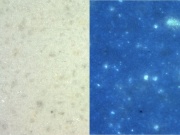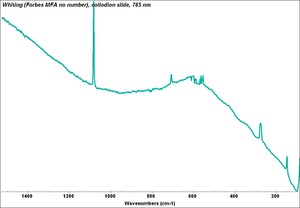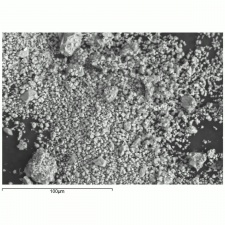Whiting
Jump to navigation
Jump to search
Description
A fine powder of white Chalk (native Calcium carbonate). Whiting has been used as an inert pigment in paints, inks, and puttys and also as a flux in low temperature ceramic glazes. Synthetically prepared calcium carbonate, called precipitated chalk, is much whiter and finer than whiting.
Synonyms and Related Terms
chalk; whitening; Spanish white; limestone whiting; Paris white; English white; gilder's whiting; Pigment White 18; CI 77220
Physical and Chemical Properties
- Small irregular shaped particles (0.1-10 microns);
- High birefringence with strong interference colors
- May fluoresce a medium purple color.
- Reacts with acids to evolve carbon dioxide.
| Density | 2.70 g/ml |
|---|---|
| Refractive Index | 1.486; 1.645 |
Comparisons
Properties of Common Abrasives
Characteristics of Common White Pigments
Additional Images
Resources and Citations
- Nicholas Eastaugh, Valentine Walsh, Tracey Chaplin, Ruth Siddall, Pigment Compendium, Elsevier Butterworth-Heinemann, Oxford, 2004
- R. J. Gettens, G.L. Stout, Painting Materials, A Short Encyclopaedia, Dover Publications, New York, 1966
- G.S.Brady, Materials Handbook, McGraw-Hill Book Co., New York, 1971 Comment: p. 181
- Reed Kay, The Painter's Guide To Studio Methods and Materials, Prentice-Hall, Inc., Englewood Cliffs, NJ, 1983
- Ralph Mayer, A Dictionary of Art Terms and Techniques, Harper and Row Publishers, New York, 1969 (also 1945 printing)
- Paint in America, Robert Moss (ed.), John Wiley & Sons, New York, 1994 Comment: Ian Bristow "House Painting in Britain"
- Susan E. Schur, Conservation Terminology: A review of Past & Current Nomenclature of Materials, Technology and Conservation, Spring (p.34-39); Summer (p.35-38); Fall (p.25-36), 1985
- Art and Architecture Thesaurus Online, https://www.getty.edu/research/tools/vocabulary/aat/, J. Paul Getty Trust, Los Angeles, 2000






